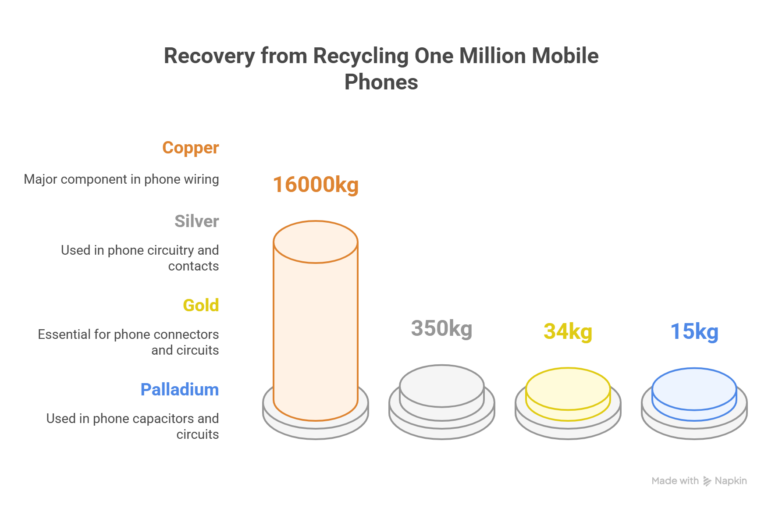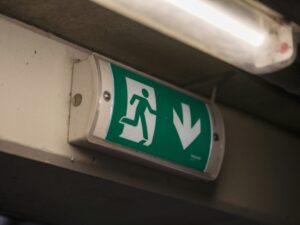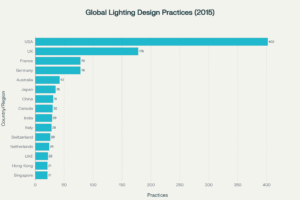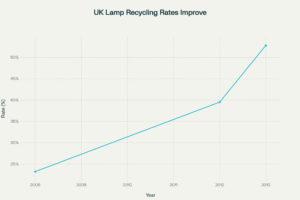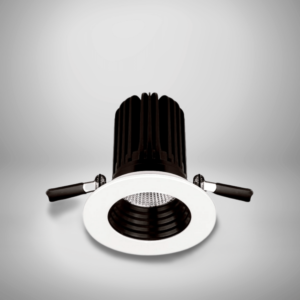A record 62 million tonnes of electronic waste was generated worldwide in 2022, yet less than a quarter of that was properly collected and recycled, leaving US $62 billion of recoverable materials at risk of being lost to landfill¹.
At the current annual growth rate, global e‑waste is on track to hit 82 million tonnes by 2030—a 32 per cent increase in just eight years—and could reach 120 million tonnes by 2050².
With only around 22.3 per cent formally recycled in 2022, the mounting legacy stockpile now exceeds 350 million tonnes³.
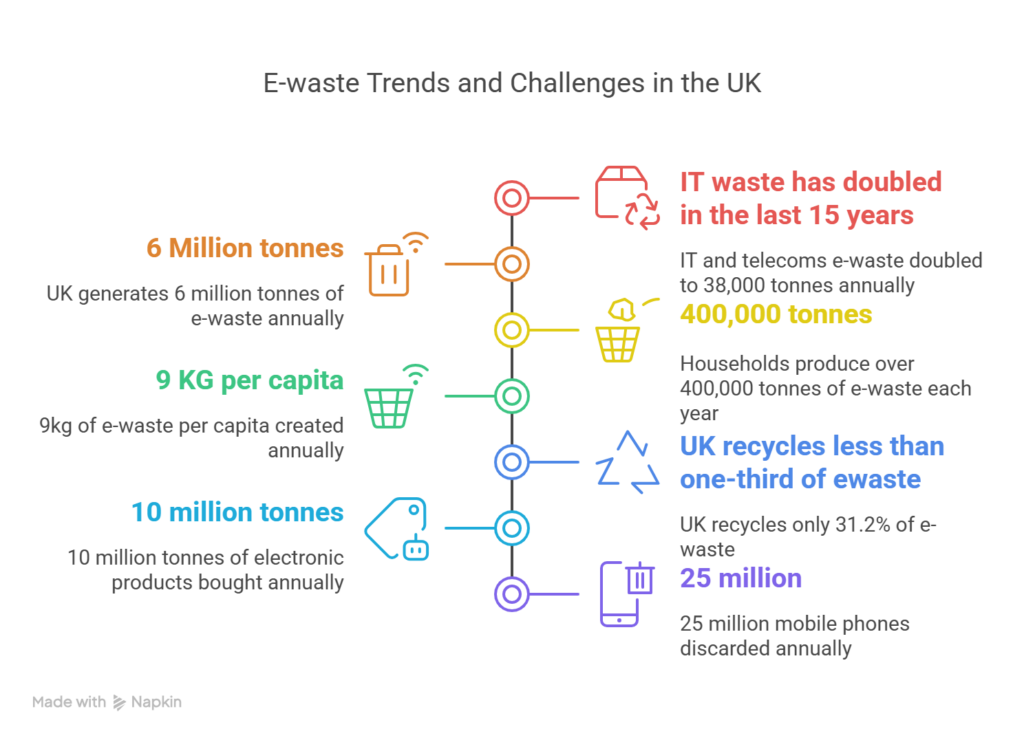
E‑Waste Recycling Dashboard
Interactive guide to understanding and managing lighting e‑waste
Global E‑Waste Statistics
Top E‑Waste Producing Countries (kilotonnes)
Why Lighting E‑Waste Deserves Special Attention
Smart & LED Street Lighting
Fluorescent & CFL Bulb Hazards
How to Recycle Lighting E‑Waste
- Catalogue all lighting assets: bulbs, tubes, fixtures, control gear
- Separate by technology: LEDs, fluorescent, HID, CFL
- Log quantities and anticipated replacement dates
- Use a spreadsheet or CMMS to track lights nearing end‑of‑life
- Look for Environment Agency or SEPA licensed collectors
- Confirm they offer lamp crushing, phosphor recovery and electronics recycling
- Check for proper certifications and compliance history
- Securely package tubes in crush‑resistant boxes or lamp shredders
- Schedule on‑site pickup or drop‑off at designated WEEE facilities
- Ensure proper handling to prevent breakage of hazardous materials
- Lamp processing: mercury vapour capture, glass separation, phosphor stabilisation
- Fixture shredding: recovery of metals (aluminium, copper), plastics and drivers
- Separation of valuable and hazardous materials for proper treatment
- Obtain a Certificate of Recycling for compliance with WEEE Regulations
- Update environmental reports and sustainability dashboards
- Document progress toward waste reduction targets
The Circular Economy & Lighting
UK E‑Waste Statistics
UK E‑Waste Collection Schemes
Frequently Asked Questions
Global Generation and Trends
Electronic waste has become the fastest‑growing solid waste stream on the planet. In 2022, global e‑waste generation reached 62 million tonnes, up 82 per cent since 2010¹. That equates to 7.8 kg per person on average⁴ and would fill over 1.5 million 40‑tonne trucks if lined up end to end⁵. Despite this surge, documented recycling has not kept pace—only 22.3 per cent of 2022’s total was properly collected and processed, down from 30 per cent in 2010¹.
The annual growth rate of e‑waste is approximately 2.6 million tonnes, forecasting 82 million tonnes by 2030 and a staggering 120 million tonnes by 2050². If collection rates remain stagnant—or fall slightly to 20 per cent by 2030—the gap between generation and recycling will widen further⁶.
Toxicity and Environmental Impact
E‑waste is laden with hazardous substances that pose severe risks to human health and ecosystems.
It accounts for roughly 70 per cent of all toxic waste globally⁷. Fluorescent lamps, batteries and circuit boards contain mercury, lead, cadmium and brominated flame retardants, which can leach into soil and water if not properly handled⁷.
Improper disposal of lighting equipment alone is estimated to release around 50 tonnes of mercury into the environment each year¹⁴. This contributes to air and water pollution, bioaccumulation in food chains and neurological damage in vulnerable populations.
On the other hand, formally recycling e‑waste prevents millions of tonnes of CO₂‑equivalent emissions. In 2022, responsible processing avoided an estimated 93 million tonnes of CO₂‑eq through material recovery and reduced need for virgin extraction⁸.
Recoverable Resource Value
Electronic devices contain a wealth of precious and base metals ready for reuse. Globally, US $62 billion worth of raw materials was discarded as e‑waste in 2022, yet under 23 per cent was reclaimed¹.
Key recovery figures include:
1 million laptops recycled saves enough energy to power 3 600 homes for one year⁹.
1 million mobile phones can yield 34 kg of gold, 350 kg of silver and 15 kg of palladium¹⁰.
1 tonne of circuit boards contains 40–800 times more gold and 30–40 times more copper than the same weight of mined ore¹¹.
These figures highlight the enormous potential of urban mining—recovering strategic metals from our own waste streams rather than depleting natural reserves.
Regional Focus: United Kingdom
The UK ranks among the highest per‑capita producers of e‑waste. In 2022, Britons generated 23.9 kg per person, second only to Norway among all nations¹². Household collections averaged 120 000 tonnes per quarter—around 480 000 tonnes annually—through municipal drop‑off points and private take‑back schemes¹³.
Formal e‑waste collection in 2022 totalled 505 445 tonnes, representing just 31.2 per cent of the UK’s waste electrical and electronic equipment (WEEE)¹⁴. Despite robust legislation (the WEEE Regulations 2013) and thousands of local collection sites, two‑thirds of UK e‑waste still evades proper processing.
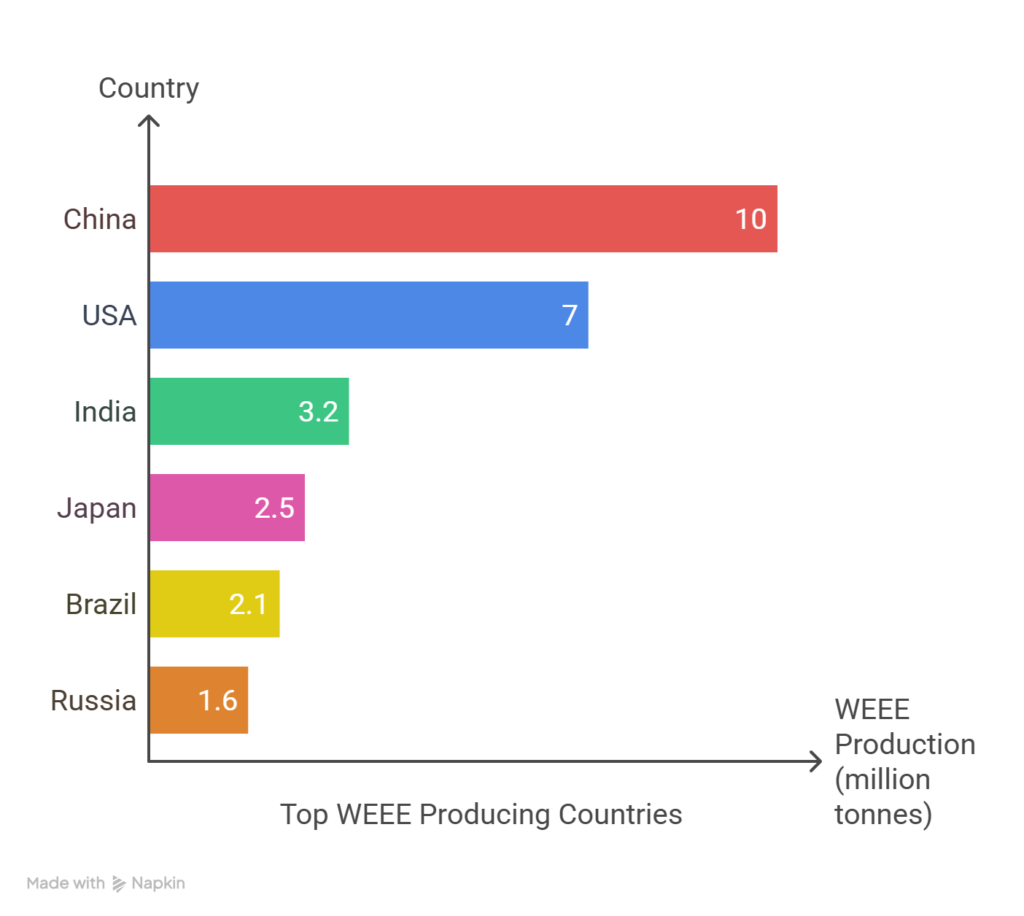
Top E‑Waste Producing Countries
| Rank | Country | E‑Waste Generated (kt, 2021) | Documented Recycling Rate |
|---|---|---|---|
| 1 | China | 10 129 | 16 per cent⁶ |
| 2 | USA | 6 918 | 15 per cent⁶ |
| 3 | India | 3 230 | 1 per cent⁶ |
| 4 | Japan | 2 569 | 22 per cent⁶ |
| 5 | Brazil | 2 143 | — |
| 6 | Russia | 1 631 | 6 per cent⁶ |
Together, these six account for over 55 per cent of global e‑waste generation⁶.
Lighting Equipment Waste
Discarded lamps and luminaires form a significant sub‑stream of WEEE. Though precise breakdowns vary, fluorescent tubes and compact fluorescents contributed roughly 1 million tonnes of lamp waste in 2019, growing at over 4 per cent annually⁶. Each CFL can contain 3–5 mg of mercury, and without proper recycling, the lighting segment alone contributes significantly to that 50 tonnes of mercury lost each year¹⁴.
Recycling programmes for lamps focus on mercury vapour capture, glass and phosphor separation, and recovery of rare earth elements—critical inputs for new LED phosphors.
Regional Recycling Rates and Challenges
Recycling performance varies widely by region. In 2019, Europe led with a 42.5 per cent e‑waste recycling rate, followed by Asia at 11.7 per cent, the Americas at 9.4 per cent, Oceania at 8.8 per cent, and Africa lagging at 0.9 per cent⁶. This uneven picture reflects disparities in infrastructure, legislation, consumer awareness and the capacity to enforce regulations.
Future Projections and Policy Imperatives
If current trajectories persist, annual e‑waste will swell to 82 million tonnes by 2030, with only 20 per cent properly recycled, unless significant investments in collection and processing are made².
By 2050, total e‑waste could reach 120 million tonnes². Closing the gap will require:
Stronger enforcement of producer responsibility and landfill bans
Expanded take‑back networks, especially in developing regions
Design for disassembly to simplify material recovery
Consumer education on safe drop‑off and donation options
Failing to ramp up these efforts will exacerbate toxic pollution, forfeit billions in resource value, and deepen the global climate footprint of electronic consumption.
References
ITU & United Nations University, Global E‑Waste Monitor 2024, 2024 E-Waste Monitor
Platform for Accelerating the Circular Economy & UN E‑Waste Coalition, “Global e‑waste on track to reach 120 Mt by 2050,” press release, 24 January 2019 UNEP – UN Environment Programme
Central Virginia Waste Management Authority, “Recycling and Energy,” CVWMA cvwma.com
Green Group, “34 kg of gold, 350 kg of silver and 15 kg of palladium recovered from one million recycled mobile phones,” 22 February 2024 Sustainability Today
U.S. EPA, “Frequent Questions about the Sustainable Materials Management Electronics Challenge,” last updated 5 months ago US EPA
Vanessa Forti, “Global electronic waste up 21% in five years, and recycling isn’t keeping pace,” World Economic Forum, July 2020 World Economic Forum
The Roundup, “17 Shocking E‑Waste Statistics In 2025,” last year TheRoundup
United Nations University, “Global E‑Waste Monitor 2024: recycling rate forecast to drop to 20% by 2030,” media release UNITAR
CVWMA (ibid.), “Recycling 1 million laptops would save the energy needed to power 3,600 U.S. homes for a year” cvwma.com
Green Group (ibid.), “Recovered from one million recycled mobile phones” Sustainability Today
U.S. EPA (ibid.), “One metric ton of circuit boards can contain 40 to 800 times the amount of gold…” US EPA
Green Economy, “UK to be top e‑waste contributor by 2024,” 13 September 2023 Green Economy
Statista, “On average, 120,000 t of household e‑waste are collected each quarter in the UK,” 2024 Statista
Statista, “In 2022, the United Kingdom formally collected less than one‑third of the e‑waste it generated, amounting to 505 445 t,” 2024 Statista
WEEE statistics.pdf, “50 tonnes of mercury lost every year through improper e‑waste disposal”
